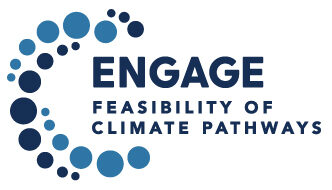
Policy Brief #41, October 2023. Embracing the notion of feasibility, this research shows that the world will probably overshoot 1.5°C, largely owing to low institutional capacity. Energy demand reduction and electrification are two options to turn down the heat, and addressing weak institutions is crucial.
In the past, climate scenarios have focused on how to curb warming for the lowest economic cost. But cost is only one factor in the overall feasibility of climate mitigation. New research accounts for other dimensions of feasibility, encompassing technology, natural resources, and the capacity of governments to implement mitigation.
Early results show that:
- Warming will probably pass 1.5°C, meaning that we should prepare for a temperature overshoot. In the most ambitious mitigation scenarios that consider feasibility constraints, the chance of keeping peak warming below 1.5°C is only 10-25%.
- Reducing energy demand improves the likelihood of staying below 1.5°C and is even more important to help reduce temperatures after a peak.
- Countries with high institutional capacity should take more responsibility for near-term mitigation. These countries include the EU, Japan, and the USA.
- International support for institutional capacity is essential for achieving ambitious decarbonization.
An ambitious goal
How can we meet the Paris goals for global temperature? To address this question, scientists use integrated assessment models (IAMs), combining climate and economic modeling to calculate mitigation scenarios. These can suggest how emissions reductions are distributed between countries, and which forms of generation and other technologies to use.
IAMs are generally set up to minimize global economic cost. This however provides a narrow perspective, being only one factor in the overall feasibility of mitigation strategies. The Exploring National and Global Actions to Reduce Greenhouse Gas Emissions (ENGAGE) project, which brings together research teams from around the world coordinated by IIASA, has developed a framework to assess feasibility concerns stemming from natural resources, technology, behavior, and institutions.
The new studies apply this framework in eight different IAMs to explore the feasibility of ambitious climate targets.
Institutional constraints turn out to be the most substantial. Several empirical studies have shown that the implementation of climate policies, such as carbon taxes and phasing out coal, is affected by institutional capacity. To represent this constraint, the studies first estimate countries’ institutional capacity (which can empirically be related to their GDP per capita, levels of higher education, and gender equality in education). The models then set limits on carbon prices and the pace of emission reductions as a function of institutional capacity, which evolve over time as governance improves.
The studies also look at constraints from technological and geophysical perspectives. Based on a wide literature review, they put plausible limits on energy generation from biomass; the total amount of CO2 that can be stored in geological formations; and how fast different countries and regions can be expected to ramp up solar, wind, and other low-carbon technologies.
Be prepared
These feasibility constraints make it more difficult to achieve the Paris targets. Without a major systemic change, the world is unlikely to constrain peak warming to 1.5°C above pre-industrial levels.
The studies focus on two temperature goals: 2°C and 1.5°C1. The tighter target has been made more difficult by increasing global emissions over the past two years, since the end of the COVID-19 pandemic. Even without imposing feasibility constraints, the models struggle to achieve it2, because of inertia in replacing high-carbon infrastructure with cleaner technology – offering a less than 40% chance of holding peak warming below 1.5°C. Adding feasibility constraints on institutions, technology, and geophysics, the models show this probability falling to 10-25%.
This can be improved by assuming two enablers: lower energy demand and greater electrification than models assume under default settings. But they only have a limited effect, improving the chance by 5-10%.
Assuming both constraints and enablers leads to a projected median overshoot of 0.2°C. We should prepare to adapt to at least that level of warming and prepare to draw down temperatures again with carbon removal after reaching net-zero. That will mean reducing residual emissions to the lowest possible levels and scaling up carbon removal technologies.
Be frugal
Reducing energy demand will enable high-governance countries to take on more responsibility for emission reduction. While probably not enough to hit 1.5°C, it should help in recovering from an overshoot. Pulling global temperature down by just 0.1°C will require about 220 gigatons (Gt) of CO2 to be removed from the atmosphere (roughly five times current annual emissions), which will need a lot of energy. Reduced demand from other quarters will leave more energy available for that task. By pioneering demand eduction, rich countries can also learn lessons for other countries to follow, and so improve the medium- and long-term feasibility of global mitigation.
Figure 1. Carbon budget outcomes across the models and the probability of staying below 1.5°C.
[Solid icons indicate that the scenario considers harmonized technological and geophysical constraints (black technologies), institutional constraints and differentiation (blue building), and social enablers of demand and electrification (green people), while grey semi-transparent icons indicate only model default assumptions].
Be responsible
Countries that can do more, must do more. Least-cost scenarios foresee most mitigation happening in countries with lower institutional capacity, where it tends to be cheaper. Institutional constraints shift that responsibility. In the ENGAGE studies, scenarios with feasibility constraints allocate most near-term mitigation to regions with high institutional capacity such as the EU, North America, and the Pacific members of the Organisation for Economic Co-operation and Development (OECD). These countries should achieve emissions cuts by 2040 of greater than 80% in order to align with peak warming of well below 2°C. The scenarios with feasibility constraints also show a larger share of mitigation in China compared to least-cost scenarios in the medium-term.
This takes a lot of pressure off the rest of the world (especially the poorest countries), which in the 2°C scenarios that include all feasibility constraints is projected to need emission cuts of 44% in 2050, instead of the 68% in the cost-effective scenario.
Pull the big lever
Mitigation faces its most significant challenge in institutional capacity, and enhancing this capacity may offer the most effective means to improve the situation. The research also examines two governance scenarios: one with carbon price capping but no restrictions on emission reductions, and another with no improvements in capacity over time. These scenarios reveal substantial variations in carbon budgets, spanning several hundred gigatons.
An effective way to speed global climate action could therefore be capacity building and knowledge transfer, focusing on institutional capacity in nations with high mitigation potential. Technology transfer will also remain important, because making technologies costcompetitive across the world enables faster scaling.
Publications on which this policy brief is based
Posted on https://www.engage-climate.org/
About the ENGAGE project
The research for this brief was led by Christoph Bertram (Potsdam Institute for Climate Impact Research (PIK) and the University of Maryland), Elina Brutschin, Keywan Riahi, and Bas van Ruijven (IIASA). The work was published in an internal report to the European Commission in August 2023.
This project has received funding from the European Union’s Horizon 2020 research and innovation programme under grant agreement No 821471 (ENGAGE).
Disclaimer: the contents of this Policy Brief do not represent the opinion of the European Community nor is the European community responsible for any use that might be made of the content appearing herein.
References and useful resources
Brutschin, E. , Pianta, S., Tavoni, M., Riahi, K. , Bosetti, V., Marangoni, G., & van Ruijven, B.J. (2021). A multidimensional feasibility evaluation of low-carbon scenarios. Environmental Research Letters 16 (6) 064069. 10.1088/1748-9326/abf0ce.
Riahi, K. , Bertram, C., Huppmann, D. , Rogelj, J. , Bosetti, V., Cabardos, A.-M., Deppermann, A., Drouet, L., Frank, S. , Fricko, O. , Fujimori, S. , Harmsen, M., Hasegawa, T., Krey, V. , Luderer, G., Paroussos, L., Schaeffer, R., Weitzel, M., van der Zwaan, B., Vrontisi, Z., Longa, F.D., Després, J., Fosse, F., Fragkiadakis, K., Gusti, M., Humpenöder, F., Keramidas, K., Kishimoto, P. , Kriegler, E., Meinshausen, M., Nogueira, L.P., Oshiro, K., Popp, A., Rochedo, P.R.R., Ünlü, G. , van Ruijven, B. , Takakura, J., Tavoni, M., van Vuuren, D., & Zakeri, B. (2021). Cost and attainability of meeting stringent climate targets without overshoot. Nature Climate Change 11 1063-1069. 10.1038/s41558-021-01215-2.
1. For 2°C, scenarios have a budget of roughly 800 Gt total CO2 emissions since 2023 – giving 66% chance of staying under 2°C, according to climate models. For the 1.5°C goal, the target is 350 Gt, or the lowest emission pathway that is still achievable in each model. In both cases, the budget is defined until the time of reaching global net zero, thus limiting peak temperature.
2. The models struggle to hit 350 Gt from 2023 and average around 440 Gt, which gives a less than 40% chance of holding peak warming below 1.5°C.




![- Figure 1. Carbon budget outcomes across the models and the probability of staying below 1.5°C.
[Solid icons indicate that the scenario considers harmonized technological and geophysical constraints (black technologies), institutional constraints and differentiation (blue building), and social enablers of demand and electrification (green people), while grey semi-transparent icons indicate only model default assumptions]. PB41](/sites/default/files/2023-09/PB41-Figure1_0.png)
